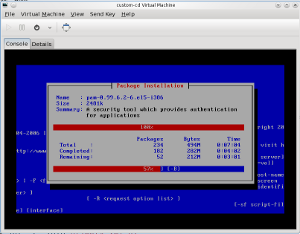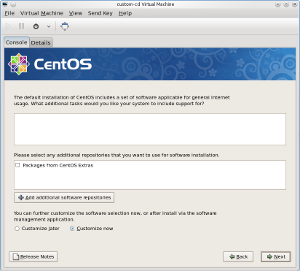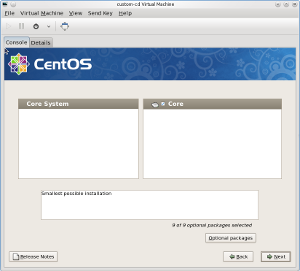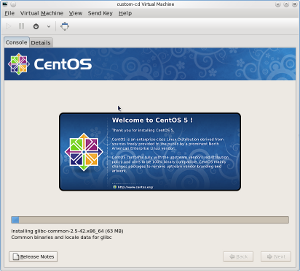Custom Linux bootable CD
From WBITT's Cooker!
(→Test the stuff you just build (the bootable ISO image)) |
(→DONE) |
||
| Line 312: | Line 312: | ||
===DONE=== | ===DONE=== | ||
| - | Here is the | + | Here is some of the information from the newly installed VM. You can see that only ssh service is running, and the install size of the system is 701MB in total. |
<pre> | <pre> | ||
Revision as of 05:43, 4 July 2010
This article is in relation to the article CENTOS Server CD project. I took some concepts from :
- http://people.redhat.com/rkeech/custom-distro.txt , which is now totally out-dated.
- http://greghaygood.com/2007/12/11/build-a-custom-centos-5-install-cd
Note: In recent versions of RedHat and CentOS, most of the steps/commands shown in link #1 above, are now taken care by a single "createrepo" command.
Contents |
First, the setup
Originally I tried to use my Fedora-11 machine (named kworkhorse), for doing all these steps of building the Custom CentOS cd. However, after burning two weeks of time, I realized that I have to build CentOS CD from a CentOS build host.
So what I did is, I simply created a small virtual machine, within my Fedora 11, which runs CentOS-5.4-x86_64. It is named "buildhost". I assigned 1GB of RAM and 3 GB of diskspace to this virtual machine. I did not use more space, because, I wanted to use least amount of disk space, and kind of re-use the already prepared "build-tree" from the Fedora11 machine. What I did was export /data/cdimages from Fedora11 host using NFS and mounted that on /mnt/cdimages on the newly CentOS VM.
The directory /data/cdimages, on my Fedora machine, contains full install tree of original CENTOS 5.4 64 bit CD in CENTOS-5.4-x86_64 subdirectory, and an empty CENTOS-5.4-x86_64-core (build) directory. When this directory is mounted on my buildhost, over NFS, the directory layout looks like the following:
[root@buildhost cdimages]# pwd /mnt/cdimages [root@buildhost cdimages]# tree -d . ├── CentOS-5.4-x86_64 │ ├── CentOS │ ├── images │ │ ├── pxeboot │ │ └── xen │ ├── isolinux │ ├── NOTES │ └── repodata └── CentOS-5.4-x86_64-core
The directory /mnt/cdimages/CentOS-5.4-x86_64-core (which is empty at the moment), will be the custom install tree, and will be referred to as build-tree or build-directory in this document. Once again:
- Machine on which CentOS CD is built: BuildHost
- OS on build host: CentOS-5.4-x86_64
- BuildDirectory: /mnt/cdimages/CentOS-5.4-x86_64-core
Required Packages on the build host
Before you continue, you must install the following packages on your base OS.
yum -y install anaconda anaconda-runtime mkisofs cdrecord
Note: anaconda-runtime is RHEL/CENTOS specific package, and is part of the RHEL/CENTOS distribution.
Off-the-topic: On Fedora, if you want to generate custom fedora spin-offs, you can use "pungi" and "revisor" . It has a wizard-like GUI interface.
yum -y install pungi revisor
Build the install tree
To create my minimal install tree, I first created a copy of the original install tree skipping the CentOS directory.
# rsync -av --exclude CentOS/ \ /mnt/cdimages/CentOS-5.4-x86_64/ /mnt/cdimages/CentOS-5.4-x86_64-core/
Note: I prefer rsync, because it copies the .dot-files too. Later, we would be needing a special file named .discinfo, from the original tree.
When done, your buildtree would look like this:
[root@buildhost CentOS-5.4-x86_64-core]# pwd /mnt/cdimages/CentOS-5.4-x86_64-core [root@buildhost CentOS-5.4-x86_64-core]# tree -d . ├── images │ ├── pxeboot │ └── xen ├── isolinux ├── NOTES └── repodata 6 directories [root@buildhost CentOS-5.4-x86_64-core]#
Now we need to copy selected RPMs from the source directory into the build directory. I created this file, by first creating a test VM using minimal kickstart, and noted the list of packages installed in it. I could not think of any easier way. The file is located in /tmp/minivm, as "installed-rpms.txt" . (Look in CENTOS Server CD project to see how I generated it. Or use the Core Packages List CentOS-5.4-x86 64 list for list of packages required for CentOS 5.4 64 bit.)
# mkdir /mnt/cdimages/CentOS-5.4-x86_64-core/CentOS/
# for filename in $(cat /tmp/minivm/installed-rpms.txt); do
cp -v /mnt/cdimages/CentOS-5.4-x86_64/CentOS/"${filename}.rpm" \
/mnt/cdimages/CentOS-5.4-x86_64-core/CentOS/
done
Make sure you copy kernel-* files to the build tree. This is important, because at times, you may be using this CD in all sorts install scenarios, such as installation of bare-metal hosts, KVM hosts, XEN hosts, etc. So you would need at least two types of kernels in your installation.
comps.xml
From the original howto: Comps file. The file $RHROOT/RedHat/base/comps.xml defines the set of packages known to the installer. The set of packages described in comps.xml must be reduced to only those required. It is not necessary to remove the unused package files from $RHROOT/RedHat/RPMS/. Some packages from $RHROOT/RedHat/RPMS/ are necessary in the process of building the install CD even though they might be excluded from the custom build.
Here is an example comps.xml file from the original howto (RHEL3 based).
As I mentioned in the related article, (borrowing the sentence/term from another author), "the comps.xml has gazillion languages represented in it". I want to at least get rid of the languages stuff from the file, so I can work on it.
Here is something interesting. The original comps.xml file (CentOS-5.4) is 11418 lines.
[root@buildhost CentOS-5.4-x86_64-core]# wc -l repodata/comps.xml 11418 repodata/comps.xml [root@buildhost CentOS-5.4-x86_64-core]#
Interestingly, there are 8811 "xml:lang" lines in it!
[root@buildhost CentOS-5.4-x86_64-core]# grep "xml:lang" repodata/comps.xml | wc -l 8811
The "xml:lang" lines look like this and repeat themselves a lot!
<name xml:lang="nl">Cluster-opslag</name>
. . .
<description xml:lang="nl">Pakketten die ondersteuning bieden voor cluster-opslag.</description>
Lets create a "language-free" version of this file.
[root@buildhost CentOS-5.4-x86_64-core]# grep -v "xml:lang" repodata/comps.xml > /tmp/no-lang.comps.xml [root@buildhost CentOS-5.4-x86_64-core]# wc -l /tmp/no-lang.comps.xml 2607 /tmp/no-lang.comps.xml
As you can see, only 2607 lines to edit! Great! It's time to edit this file, remove anything which is not related to us, and replace the repodata/comps.xml file with the new one.
Here is the (80 lines) file I ended with: Comps.xml for CentOS-5.4-x86 64 minimal install !!!
Now remove all files in repodata/* and copy your newly created file to repodata, as comps.xml .
[root@buildhost CentOS-5.4-x86_64-core]# pwd /mnt/cdimages/CentOS-5.4-x86_64-core [root@buildhost CentOS-5.4-x86_64-core]# rm repodata/* -f [root@buildhost CentOS-5.4-x86_64-core]# cp /tmp/no-lang.comps.xml repodata/comps.xml
Building the stuff
The RHEL3 based howto recommends to run the commands pkgorder, buildinstall, etc, on the build tree. This is no longer valid. A simple createrepo command takes care of everything.
Testing the RPMs for any dependency errors
It is a good idea to do a test install of your RPMs, in a test directory. This will point out any dependency problems.
[root@buildhost CentOS]# pwd /mnt/cdimages/CentOS-5.4-x86_64-core/CentOS [root@buildhost CentOS]# mkdir /tmp/testrpmdb [root@buildhost CentOS]# rpm --initdb --dbpath /tmp/testrpmdb/ [root@buildhost CentOS]# rpm --test --dbpath /tmp/testrpmdb/ -ivh *.rpm warning: acl-2.2.39-3.el5.x86_64.rpm: Header V3 DSA signature: NOKEY, key ID e8562897 Preparing... ########################################### [100%] [root@buildhost CentOS]# [root@buildhost CentOS]# echo $? 0 [root@buildhost CentOS]# du -sh /tmp/testrpmdb/ 640K /tmp/testrpmdb/
Had there be a package in that directory, which would be dependent on some other packages, then you would definitely get errors, which you can fix. For an example, I copied the rpm for httpd in this build directory.
[root@buildhost CentOS]# cp /mnt/cdimages/CentOS-5.4-x86_64/CentOS/httpd-2.2.3-31.el5.centos.x86_64.rpm .
And then, I run the RPM test install again:
[root@buildhost CentOS]# rpm --test --dbpath /tmp/testrpmdb/ -ivh *.rpm
warning: acl-2.2.39-3.el5.x86_64.rpm: Header V3 DSA signature: NOKEY, key ID e8562897
error: Failed dependencies:
libapr-1.so.0()(64bit) is needed by httpd-2.2.3-31.el5.centos.x86_64
libaprutil-1.so.0()(64bit) is needed by httpd-2.2.3-31.el5.centos.x86_64
[root@buildhost CentOS]#
As you can see, in the above example, either you remove the httpd RPM, or add libapr libraries too, to the CentOS directory inside your build directory. I am sure, you are intelligent enough to figure out the rest.
Note: Some documents on the net recommend that you copythe following in the CentOS directory in your build-tree, as it is suspected that they are needed for the anaconda installer to run properly. However, please note that I was able to create a CD "without" these RPMs , and was also able to install a VM using the the GUI of anaconda installer. These (not needed) packages are :
anaconda anaconda-runtime anaconda-help anaconda-product busybox busybox-anaconda memtest86+ fonts-xorg-base xorg-x11 joe
createrepo
Now is the time to run createrepo. Before you run that, you need to get some information from the .discinfo file. It is included in the root directory of the CentOS/RHEL CD/DVD. If you did an rsync (or wget) to get these files from the source location, you should have it in the top level of your build-directory. Here is how it looks like:
[root@buildhost CentOS-5.4-x86_64-core]# pwd /mnt/cdimages/CentOS-5.4-x86_64-core [root@buildhost CentOS-5.4-x86_64-core]# cat .discinfo 1254416275.453877 Final x86_64 1,2,3,4,5,6,7 CentOS/base /home/buildcentos/CENTOS/5.4/en/x86_64/CentOS CentOS/pixmaps
Lets move forward.
[root@buildhost CentOS-5.4-x86_64-core]# export discinfo=$(head -1 /mnt/cdimages/CentOS-5.4-x86_64-core/.discinfo) [root@buildhost CentOS-5.4-x86_64-core]# echo $discinfo 1254416275.453877
Now, run the createrepo command. Remember that we removed everything in the repodata directory and only placed our (very small/trimmed down), comps.xml in that directory.
[root@buildhost CentOS-5.4-x86_64-core]# createrepo -u "media://$discinfo" \ -g repodata/comps.xml /mnt/cdimages/CentOS-5.4-x86_64-core 444/444 - CentOS/mailx-8.1.1-44.2.2.x86_64.rpm Saving Primary metadata Saving file lists metadata Saving other metadata [root@buildhost CentOS-5.4-x86_64-core]#
Create Bootable ISO file
If the previous step did not give you any errors, you are now ready to create the actual bootable CD / ISO file out of this build-tree. (There is nothing worse then dead air!)
[root@buildhost CentOS-5.4-x86_64-core]# export isofilename=/mnt/cdimages/CentOS-5.4-x86_64-core.iso
[root@buildhost CentOS-5.4-x86_64-core]# mkisofs -r -R -J -T -v \
-no-emul-boot -boot-load-size 4 -boot-info-table \
-V "CentOS-5u4-core 64 bit" -p "Kamran" -A "CentOS-5u4-core 64 bit-2010/07/02" \
-b isolinux/isolinux.bin -c isolinux/boot.cat -x "lost+found" \
-o $isofilename /mnt/cdimages/CentOS-5.4-x86_64-core
INFO: UTF-8 character encoding detected by locale settings.
Assuming UTF-8 encoded filenames on source filesystem,
use -input-charset to override.
mkisofs 2.01 (cpu-pc-linux-gnu)
Scanning /mnt/cdimages/CentOS-5.4-x86_64-core
Scanning /mnt/cdimages/CentOS-5.4-x86_64-core/images
. . .
95.65% done, estimate finish Sat Jul 3 20:20:09 2010
97.60% done, estimate finish Sat Jul 3 20:20:10 2010
99.56% done, estimate finish Sat Jul 3 20:20:08 2010
Total translation table size: 146726
Total rockridge attributes bytes: 62153
Total directory bytes: 98304
Path table size(bytes): 112
Done with: The File(s) Block(s) 255876
Writing: Ending Padblock Start Block 255991
Done with: Ending Padblock Block(s) 150
Max brk space used c2000
256141 extents written (500 MB)
[root@buildhost CentOS-5.4-x86_64-core]#
Implant MD5SUM in the ISO file
The following will implant the ISO file's MD5 inside the ISO file itself.
[root@buildhost CentOS-5.4-x86_64-core]# implantisomd5 $isofilename Inserting md5sum into iso image... md5 = 48a3456517149f584ae81f793b933459 Inserting fragment md5sums into iso image... fragmd5 = 6cae56578bb59bb8bd2289af35fa7c4f4468658de47f45e6d488be9b6b33 frags = 20 Setting supported flag to 0 [root@buildhost CentOS-5.4-x86_64-core]#
Test the stuff you just build (the bootable ISO image)
Ok, now the CD is created, as a result of last (mkisofs) step. I tested it to create a VM , on my Fedora 11 KVM host. It worked without a problem, in both text and GUI mode. Here are a few screen shots!
DONE
Here is some of the information from the newly installed VM. You can see that only ssh service is running, and the install size of the system is 701MB in total.
[kamran@kworkhorse cdimages]$ ssh root@192.168.122.61 The authenticity of host '192.168.122.61 (192.168.122.61)' can't be established. RSA key fingerprint is a1:0e:0b:01:92:6a:69:14:e6:62:6d:83:6d:08:16:1d. Are you sure you want to continue connecting (yes/no)? yes Warning: Permanently added '192.168.122.61' (RSA) to the list of known hosts. root@192.168.122.61's password: Last login: Sat Jul 3 20:53:08 2010 [root@custom-cd ~]# netstat -antp Active Internet connections (servers and established) Proto Recv-Q Send-Q Local Address Foreign Address State PID/Program name tcp 0 0 :::22 :::* LISTEN 1736/sshd tcp 0 0 ::ffff:192.168.122.61:22 ::ffff:192.168.122.1:48069 ESTABLISHED 2154/0 [root@custom-cd ~]# df -h Filesystem Size Used Avail Use% Mounted on /dev/hda1 2.7G 701M 1.9G 28% / tmpfs 250M 0 250M 0% /dev/shm [root@custom-cd ~]#
The first thing, which you might want to do on this newly installed system is update it full, to bring it upto the latest version of kernel and the distribution. The benefit of such small installation is that the update will pull relatively less amount of packages, compared to a larger install. If you are connected to the internet, this should complete in minutes. Later, whatever packages you want to add, they will be pulled from the updates repository (if you have it configured that way).
[root@custom-cd ~]# yum -y update
Note: If you want, you can further remove extra packages from the newly installed system. You can use the following as a guide line: Packages which can be removed after Core installation .
Further reading
- http://cinq.com/2008/04/14/rebuilding-the-dvd-iso-for-centos-5-or-rhel-5/
- http://www.linuxjournal.com/article/6473?page=1,0
- http://www-oss.fnal.gov/projects/fermilinux/common/anaconda.comps.html
- http://fedoraproject.org/wiki/PackageMaintainers/CompsXml
- http://createrepo.baseurl.org/
- http://mirror.centos.org/centos/4/build/distro/build.sh.txt





